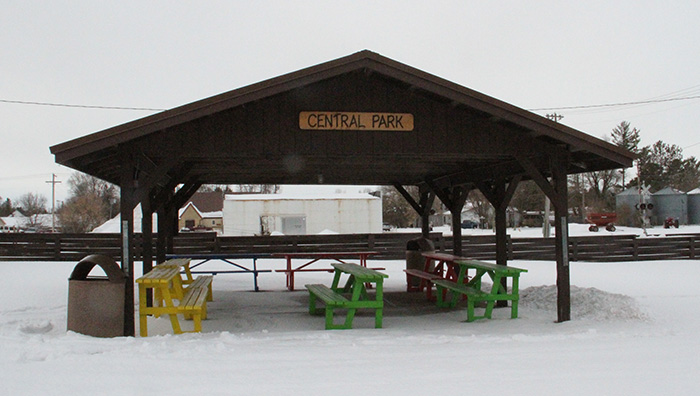Some interesting tidbits about the history of NYM
Socials | Published on February 24, 2021 at 5:10pm GMT+0000 | Author: Chad Koenen
0
Central Park in New York Mills not only shares its name with the popular park in New York City, but is located in the approximate area of hte first sawmill erected by the New York Mills Company circa 1872.
By Tucker Henderson
Special to the Dispatch
Well, here I am, less than twelve hours before the deadline to submit to the paper, with only a sentence written. You would think that I would learn from my own history that I need to set aside some time and write a few history articles before Friday comes. Oh well, I suppose it makes me think a bit more creatively, you know “necessity is the mother of all inventions.”
Here are some tidbits of New York Mills and surrounding area history.
Did you know that New York Mills once had a Catholic church? It’s true, Finnish Lutherans have not always dominated the area.
When the New York Mills Company from which the town draws its name began their lumbering in the early 1870s, “Yankees” were the first workers and residents of the area. These people needed a church to fulfill their spiritual needs.
It’s unknown when the church was first established, but the congregation moved to Bluffton around 1906 and the St. Peter’s congregation bought their unused building around 1908.
When grapefruit was first introduced to this area, people did not enjoy it at all. It was supplied by the government for the schools in the area. Boys played football with the unused grapefruit and farmers fed them to their pigs. Well, the pigs didn’t like it either!
After a few years, people learned to like it. As Lempi Perala put it, “They were never introduced to it in the proper way.”
Oranges had the same effect on a group of girls when they bought them as a novelty at a NY Mills festival. They bit into them like apples and quickly threw them away.
Many people may still remember NY Mills mayor, John Mark. Much like myself, he was a Finn without a Finnish-sounding name. He helped the town get a water and sewer system, along with paved streets, and a top-of-the-line high school running track.
He was also known for his “Markisms,” which came from his somewhat-broken English. He was a friend of Governor Floyd Olson. After a speech by the Governor, he once said “Ok, now let’s give Floydie the claps.” He also called his political opponents “sons of britches.”
Otter Tail County has had two unsuccessful attempts to divide into two counties. The latest one was encouraged by many Finns in the area. Prizes were even awarded to those who received the largest amounts of signatures for a petition to divide.
The Farmers and Merchants State Bank even advertised themselves as the “largest bank in Clover County” in the old Finnish newspaper, Uusi Kotimaa, which was printed out of New York Mills.
Woodland Cemetery was first called “Hagel Cemetery” after the beloved Apostolic preacher, Israel Hagel who donated the land. The Apostolic Church needed a cemetery and Israel generously donated a chunk of his land for that use.
The church wanted it to be a member-only cemetery, but Israel would not hear of it. He said that he would only donate the land if all community members were welcome to be buried there. The church agreed and hundreds of Finns and other community members have since been buried there.
Do you know the history behind Central Park in New York Mills? You may have seen the Continental Divide monument or even the tribute to the Finnish pioneers in the area, but Central Park is located in the approximate area of the first sawmill erected by the New York Mills Company circa 1872.
Though the sawmill sold out only ten years after its start, its last remnant, a planing mill, “gave its dying breath” in the 1940s. The owners of the NYM Co. were still named and involved in property disputes 100 years after the Company was dissolved, which was long after all of their deaths.
Enjoy reading? A book titled “All This Wild Land” (now out of print) is set in the 1870s in the area of New York Mills. The author, Ann Nolan Clark, was taken on a tour of the surrounding countryside by Russ and June Parta and she picked the perfect site next to a lake to set her next novel. The town’s name was changed to “Yankee Mills” and the Finnish family was dreamt up, but it is an enjoyable read, nonetheless.
Fire has been a deadly force in NY Mills a few times in history. Around 1895, what seemed to be a prairie fire burned up “hundreds of tons” of hay, many cattle, and even killed one unfortunate woman.
Another fire, in 1905, started from a defective chimney on the City Hotel and a large building was completely destroyed. The fire was thought to have been extinguished several hours afterward, but sparks had blown from the ashes of the building and caught several businesses, including the New York Mills Telephone Company on fire. It was noted that “The entire village was only saved by hard work.”

